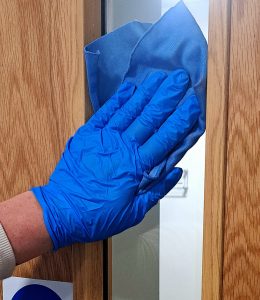Cleaning may seem like a straightforward task, but many people make simple mistakes that lead to lacklustre results or even damage to items and surfaces. Whether you’re tidying up your home, office, or commercial space, below are some of the most common cleaning mistakes and how to avoid them, so you can achieve a spotless, fresh environment with less effort. A few small adjustments can make all the difference.
Not Reading the Label Properly
It’s easy to grab a cleaning product and assume it will do the job without much thought. However, not reading the label properly can lead to ineffective cleaning or, worse, cause damage to your surfaces or fabrics. Each product is formulated for specific tasks, and using the wrong one can create problems. All cleaning products will have clear directions on the label, and it’s crucial to check this information—it’s there for a reason. For example, disinfectants often have a required contact time—this is the period the product needs to remain on the surface to effectively kill germs and bacteria. If you don’t follow this contact time, you may leave harmful pathogens behind, defeating the purpose of cleaning altogether.
How to fix it:
Always take the time to read the label before using any cleaning product. Check for important details such as the recommended applications, dilution ratios, and any precautions. For example, using a harsh bathroom cleaner on delicate wooden furniture could cause irreversible damage. By following the product instructions, you can ensure it will work effectively, safely, and as intended, protecting both your surfaces and your health

Ignoring Areas That Look Clean
It’s tempting to skip over areas that look clean, especially when you’re in a rush. But ignoring these areas can result in missed spots, dust, and germs accumulating where they’re least expected. Even spaces that appear clean can harbour dirt, bacteria, or allergens that need attention.
How to fix it:
Don’t just focus on the obvious areas like countertops and floors. Pay attention to less visible spots, such as light switches, door handles, the tops of furniture, and behind appliances. Regularly cleaning these often overlooked areas prevents grime from building up and ensures a thorough, hygienic result.
Underestimating the Time Needed to Thoroughly Clean
Cleaning is not a task that can be rushed if you want to get it right. Underestimating the time needed to do the job properly can result in a half-hearted clean and leave areas unfinished. Whether it’s wiping down surfaces, deep cleaning a bathroom, or washing the floors, rushing through the process means cutting corners.
How to fix it:
Give appropriate time to clean. Don’t attempt to clean an entire building in just one hour. Instead, break the task into manageable chunks—whether by room or by type of surface—and allocate sufficient time for each. This ensures you’re not rushing and having to prioritise some tasks whilst missing others.
Not Using the Right Tools for the Job
Using the wrong tools or cleaning implements is another mistake that can lead to poor results. For example, scrubbing delicate surfaces with a harsh brush or using a general-purpose cloth to clean glass can cause streaks. Not using the right tools means you’re not making the most of your cleaning products, and you may even damage your surfaces.
How to fix it:
Make sure you’re using the appropriate tools for each task. Use microfibre cloths for dusting and cleaning glass, a soft-bristled brush for scrubbing delicate surfaces, and a mop with the right head for your floors. The right tools not only make cleaning easier but also ensure you get the best results while keeping your surfaces in good condition.

Overlooking the Need for Regular Maintenance
Many people only clean their space when it becomes noticeably dirty, but neglecting regular maintenance means that dirt and dust accumulate, meaning the job is harder and takes longer when it’s time to clean thoroughly. It’s far easier to maintain a clean space than to tackle a large, built-up mess.
How to fix it:
Establish a routine cleaning schedule to keep things in check. Simple tasks like wiping down surfaces daily, vacuuming high-traffic areas, and keeping clutter to a minimum can prevent dirt from accumulating. A bit of regular maintenance will save you time and effort in the long run and keep your home or office looking fresh.
Using Too Much or Too Little Product
It’s a common mistake to assume that more cleaning product will lead to better results. However, using too much product can result in sticky residue or excess chemicals being left behind, while using too little might not clean effectively. Getting the balance right is key.
How to fix it:
Always follow the instructions on the product label regarding how much to use. In most cases, less is more—using too much cleaner can leave residues that attract dust or dirt more quickly. Conversely, using too little means the cleaner might not work as intended. If in doubt, start with a small amount and add more as needed.
Cleaning from the Bottom Up
A common mistake is to start cleaning from the floor and work your way upwards. The problem with this is that dust and dirt from higher surfaces will fall to the floor, meaning you’ll have to clean it again.
How to fix it:
Always clean top to bottom. Begin by dusting shelves, light fixtures, and countertops before moving on to the floor. This way, any dust or debris that falls during cleaning will land on areas you’ve yet to clean, rather than ruining the work you’ve already done.
Thinking Everyone Knows How to Clean
It’s a common misconception that cleaning is simple, with the assumption that everyone knows how to clean and clean to the same standard. What one person considers “clean” might not meet the expectations of someone else. This is because everyone has had different experiences and lifestyles, which shape their perspective on what cleanliness means and how it should be achieved. For instance, a person used to a highly organised environment may have different standards to someone who doesn’t prioritise tidiness as much, leading to varying cleaning expectations and outcomes.
How to fix it:
The key to avoiding this misunderstanding is to establish clear cleaning expectations and communicate openly with everyone involved. In a professional setting having training from an experienced and knowledgeable source is vital it can help ensure that cleaning standards are met across all areas within a workplace. For home cleaning, there are plenty of best practice videos available on YouTube and through various online resources. These can offer helpful tips and techniques to ensure that your cleaning process is as effective as possible.

Final Thoughts
Cleaning is a task that everyone has to do, but avoiding these simple mistakes can make the process quicker, more effective, and less stressful. By taking the time to read labels, creating a schedule/rota, and ensuring you’re using the right amount of product and tools, you’ll be able to clean smarter, not harder. In addition, clear communication about cleaning standards can help maintain a high level of cleanliness in shared spaces, ensuring everyone is on the same page.
With these small adjustments to your cleaning routine, you’ll achieve better results in less time.
Happy cleaning!
If your workplace requires the expertise of a trained, knowledgeable cleaning operative, feel free to drop us a message on our Contact Us page – we’re here to help ensure your space stays spotless and hygienic.



